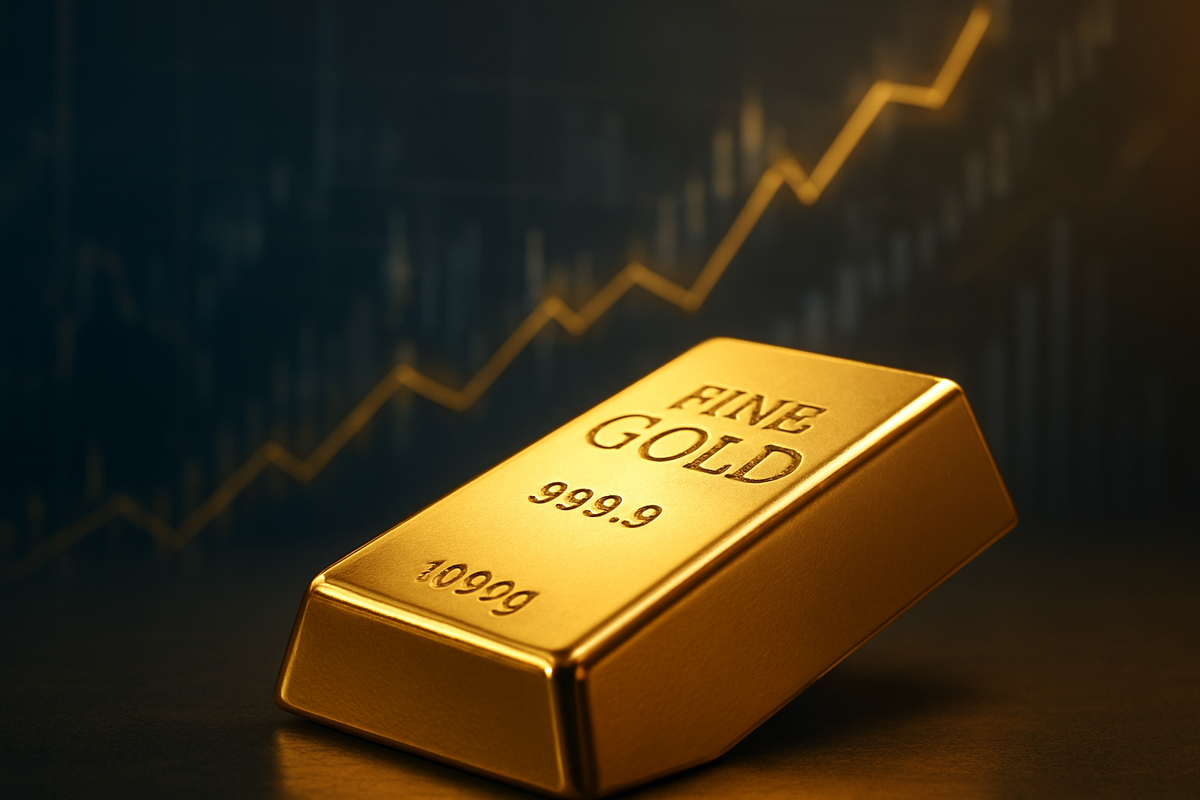
Gold has embarked on an extraordinary rally throughout 2025, defying conventional market wisdom and reaching unprecedented price levels. The precious metal has not only surpassed the significant $4,000 per ounce mark but also touched an all-time high of approximately $4,381.58 in October. This remarkable ascent, representing a year-to-date gain exceeding 50%, has firmly positioned gold as one of the top-performing major asset classes, signaling a profound shift in global economic and geopolitical landscapes.
As of November 10, 2025, gold is consolidating around the $4,084 per ounce level after a brief correction, with investor sentiment remaining cautiously bullish. The immediate implications for financial markets are multifaceted, ranging from increased volatility to a noticeable shift in investor behavior towards non-traditional U.S. investments. This sustained demand from both institutional and retail investors, coupled with robust central bank accumulation, underscores gold's re-emerging role as a critical safe-haven asset amidst a backdrop of persistent inflation, geopolitical tensions, and economic uncertainties.
An Unprecedented Ascent: Technical Analysis and Market Reactions
Gold's recent rally is a culmination of several powerful forces, propelling its price through significant technical and psychological barriers. The journey began with strong momentum in late 2024, where gold set 40 new all-time highs, peaking at US$2,778 per ounce. The rally accelerated dramatically in 2025, with gold breaching the US$3,000 per ounce mark for the first time on March 18, an event that surprised many forecasters with its speed. By April, it hit $3,500, and by October, it surpassed $4,000, ultimately reaching its zenith around $4,381.98 per ounce. As of November 10, 2025, gold is trading around $4,082.58, undergoing a period of consolidation.
This historic climb has been influenced by a complex interplay of factors. Macroeconomic drivers, including stubborn global inflation and the anticipation of interest rate cuts by major central banks (such as the U.S. Federal Reserve), have reduced the opportunity cost of holding non-yielding gold. Unprecedented demand from central banks, particularly from emerging markets, seeking to diversify away from the U.S. dollar, has provided a strong structural underpinning. Heightened geopolitical tensions, including ongoing conflicts and trade disputes, have further cemented gold's appeal as a safe haven. Furthermore, a weaker U.S. dollar and a resurgence of Western investor demand, evidenced by rising gold-backed Exchange Traded Fund (ETF) inflows, have added significant momentum. Domestic U.S. issues, such as a prolonged government shutdown and weak economic data, have also contributed to investor uncertainty, bolstering gold's allure.
From a technical perspective, gold entered a consolidation phase after its mid-October peak. Key resistance levels are identified around $4,040-$4,050, with more significant hurdles at $4,100-$4,114 and the all-time high of $4,378-$4,381.98. Support levels are crucial, with the pivotal $4,000 per ounce level acting as immediate support, followed by strong short-term support around $3,900-$3,930. Technical indicators, such as the Relative Strength Index (RSI) recovering to 51 and the Moving Average Convergence Divergence (MACD) showing early signs of a positive crossover, suggest improving momentum after a period of profit-taking. Initial market reactions have been largely bullish, with a "buy on dips" mentality prevailing. Analysts from institutions like Morgan Stanley, UBS, and Goldman Sachs have repeatedly revised their forecasts upwards, though some, like HSBC, maintain a more cautious near-term outlook, projecting a trading range of $4,050–$3,700 for the remainder of 2025.
Corporate Fortunes: Winners and Losers in Gold's Ascent
Gold's sustained rally has created a clear dichotomy of winners and losers among public companies, primarily impacting those directly involved in the precious metals industry and those reliant on gold as a raw material.
The Winners: Gold Mining, Royalty, and Streaming Companies are the direct beneficiaries. Higher gold prices translate directly into increased revenues and expanded profit margins due to their operational leverage. This often leads to appreciating stock valuations and enhanced investor confidence. For instance, major gold producers have seen gains exceeding 100% in 2025, significantly outperforming gold's own approximately 60% gain. Companies like Newmont Corporation (NYSE: NEM), one of the world's largest gold producers, and Barrick Gold Corporation (NYSE: GOLD / TSX: ABX) are poised for substantial revenue growth. Barrick, for example, reported a 15% increase in revenues and a 93% rise in net earnings in the first half of 2025. Agnico Eagle Mines Limited (NYSE: AEM) and royalty company Royal Gold, Inc. (NASDAQ: RGLD) also benefit significantly. Even smaller players like Centerra Gold (TSX: CG) have seen impressive gains, with a 69.82% increase over the past 12 months. This increased profitability allows miners to monetize previously uneconomical reserves, invest in exploration, and pursue strategic acquisitions, improving their long-term financial outlook.
The Losers: Industries Reliant on Gold as a Raw Material face significant headwinds. For Jewelry Manufacturers and Retailers (e.g., Tiffany & Co., a subsidiary of LVMH Moët Hennessy Louis Vuitton (EPA: LVMH)), soaring gold prices directly increase raw material costs. With poor consumer sentiment, passing these costs onto consumers is challenging, potentially leading to reduced sales volumes as consumers opt for lighter gold, alternative materials, or second-hand markets. Similarly, Electronics Manufacturers, particularly in semiconductor packaging and testing, are hit hard. Gold is a critical component in many electronic devices, and its rising cost can constitute over 70% of raw material costs in processes like gold-bumping. Companies like Chipbond Technology have already reported a drop in gross margins due to surging gold costs and have announced price hikes. Furthermore, the underlying macroeconomic conditions driving the gold rally, such as inflation and economic uncertainty, can erode consumer purchasing power, negatively impacting Discretionary Retail, Travel, and Hospitality Companies. Even some High-Cost Gold Mining Companies with persistently high All-in Sustaining Costs (AISC) may see their profit margins squeezed despite rising prices.
A Broader Significance: De-dollarization and Systemic Shifts
Gold's recent rally extends far beyond mere market speculation; it signifies deep-seated shifts in global economic and geopolitical dynamics. This event is intrinsically linked to broader industry trends, including the accelerating trend of de-dollarization. Central banks globally, particularly from emerging economies, are accumulating gold at an unprecedented pace, reflecting a strategic, long-term diversification away from the U.S. dollar. This "official sector buying" is a cornerstone of the rally and indicates a potential global realignment in currency reserves, signaling a structural erosion of confidence in fiat systems.
The rally's wider significance also stems from escalating geopolitical instability. Ongoing conflicts, trade disputes, and political uncertainties (including a protracted U.S. government shutdown) enhance gold's traditional role as a safe-haven asset. Persistent inflationary pressures and fears of an economic slowdown further drive investors to gold as a hedge against the debasement of fiat currencies. Interestingly, while gold has surged, other traditional safe-haven assets like the Japanese Yen have shown weakness, and Bitcoin has also rallied alongside gold, suggesting a broader sentiment of dollar weakness and a global financial shift towards alternative stores of value.
Ripple effects are evident across various sectors. Gold mining companies are experiencing a boom, potentially leading to increased exploration and M&A activity. Conversely, industries reliant on gold as a raw material face significant cost pressures. Regulatory bodies like the Commodity Futures Trading Commission (CFTC) are expected to increase oversight on market volatility, while central banks face a delicate balancing act to manage inflationary pressures without stifling economic growth. Historically, gold rallies have coincided with periods of significant currency debasement and geopolitical stress, such as the 1970s and 1980s, and the post-9/11 era. The current surge represents the third-largest rally in five decades by percentage gain, underscoring its historical significance. Experts largely view the rally as sustainable, driven by structural factors rather than temporary phenomena, with many forecasting continued appreciation into 2026 and beyond, with some projections even reaching $5,000 per ounce.
What Comes Next: Sustained Momentum or Consolidation?
The future trajectory of gold's price movements is a subject of intense debate, yet the prevailing sentiment leans towards continued strength, albeit with potential periods of consolidation. In the short-term (next 3-12 months), several factors could sustain the rally. Anticipated interest rate cuts by global central banks, particularly the U.S. Federal Reserve, are a primary driver, as lower real interest rates reduce the opportunity cost of holding non-yielding gold. A weaker U.S. dollar, persistent inflation concerns, and sustained central bank buying are also expected to provide continued tailwinds. Geopolitical risks and economic uncertainty further amplify gold's safe-haven appeal. However, potential headwinds include an unexpectedly stronger U.S. dollar, a more hawkish Fed stance, or a moderation in central bank buying from record levels. Short-term forecasts generally see gold trading in a range of $3,700-$4,050 for the remainder of 2025, with some analysts targeting $4,200-$4,700 by early 2026.
In the long-term, the outlook remains robustly bullish. Structural central bank demand, gold's proven ability as an inflation hedge and portfolio diversifier, rising global debt levels, and concerns about currency debasement are expected to maintain gold's appeal for years to come. Long-term projections from institutions like J.P. Morgan Research and Goldman Sachs see gold averaging $4,000 per ounce by mid-2026, with more optimistic forecasts reaching $5,000 by mid-2027 and even $10,000 by the end of 2034.
Market participants will need to adapt their strategies. Investors are advised to consider a strategic allocation to gold as a core component for long-term wealth preservation and diversification, potentially utilizing dollar-cost averaging to mitigate volatility. Close monitoring of real yields, central bank activity, ETF flows, and macroeconomic data will be crucial. For gold mining companies, strict cost management, capital discipline, innovation, and a focus on sustainable practices are essential to capitalize on higher prices and improve valuations. Emerging markets are expected to remain key drivers of demand, both from central banks and retail investors, but face challenges related to political instability and environmental concerns. Potential scenarios range from a significant upside driven by aggressive Fed cuts and escalating geopolitical risks, to a base case of stable prices with moderate upside, or a bear case involving a stronger dollar and de-escalation of conflicts.
The Golden Future: A Summary and Investor's Watchlist
Gold's historic rally in 2025 is a testament to its enduring role as a fundamental asset in a turbulent global economy. The key takeaways underscore a record-breaking performance, with gold and gold equities outperforming most other asset classes, driven by unprecedented central bank demand, escalating geopolitical tensions, a de-dollarization trend, persistent inflation, and expectations of U.S. Federal Reserve rate cuts. This rally is not a fleeting phenomenon but rather a reflection of deep structural shifts, signaling a "new era of structural strength" for the precious metal.
Moving forward, the market assessment remains largely bullish. While short-term volatility and corrections, like the one observed in late October, are natural and even healthy, the underlying drivers suggest a prolonged period of strength. Forecasts consistently point to continued upside potential, with many analysts seeing gold pushing towards and beyond $4,000-$5,000 per ounce in the coming years. The significance and lasting impact of this rally lie in gold's reaffirmation as a crucial safe haven and a powerful portfolio diversifier, particularly amidst a potential "currency regime shift" and an erosion of confidence in traditional fiat systems. Gold is increasingly serving as a barometer for global financial and political stability.
For investors, the coming months will require vigilance and strategic positioning. A strategic, mid-single-digit allocation to gold within diversified portfolios is increasingly recommended as a structural necessity. "Buy the dip" opportunities may emerge during periods of consolidation, especially given that many investors are still considered under-allocated. Crucially, investors should closely monitor key economic indicators such as U.S. inflation data, jobs reports, and any shifts in the Federal Reserve's monetary policy, particularly regarding interest rate cuts. The evolving geopolitical landscape, central bank gold purchasing patterns, and the strength of the U.S. dollar will continue to be significant drivers. Finally, while physical gold and gold ETFs offer direct exposure, gold equities may still present value, with strong margins and improved capital discipline.
This content is intended for informational purposes only and is not financial advice







